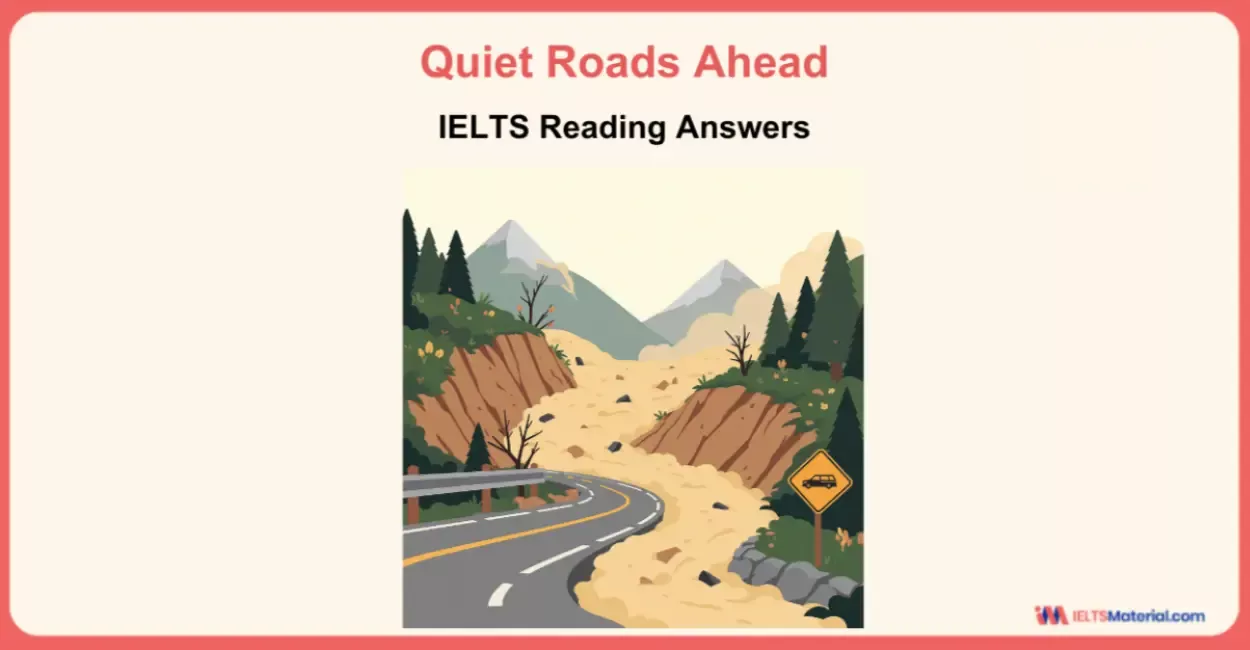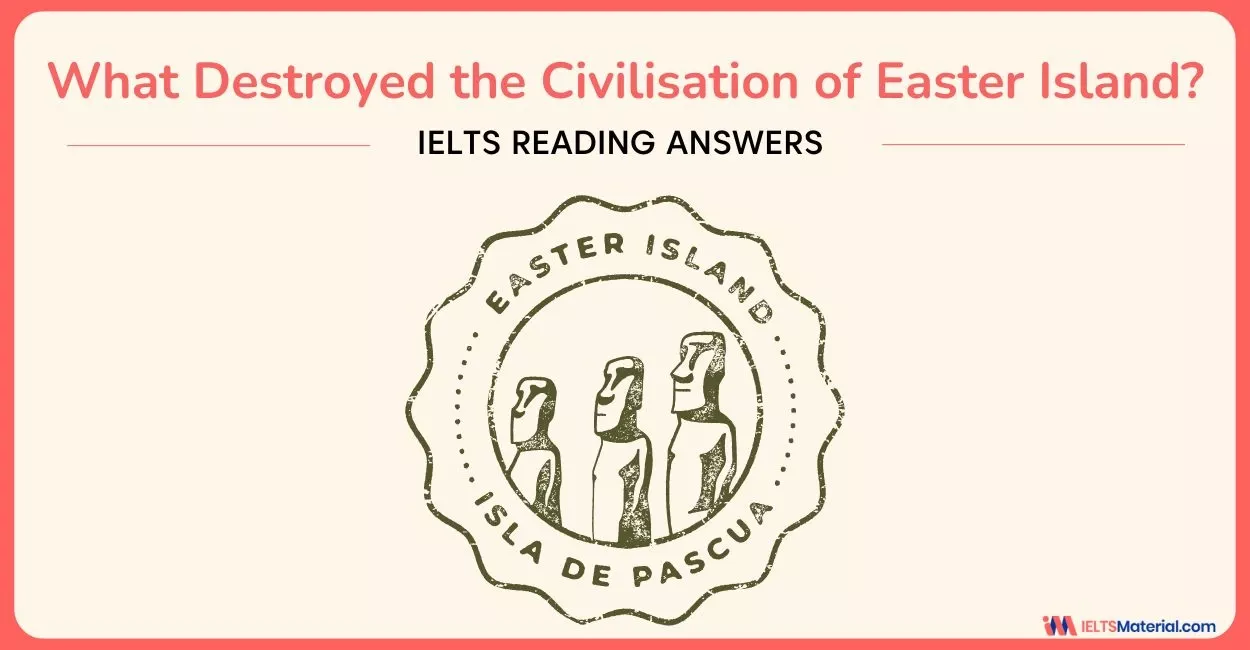What Destroyed the Civilisation of Easter Island? - IELTS Reading Answers with Explanation
16 min read
Updated On
-
Copy link
Boost your IELTS reading score to a band 8+ by using the ‘What Destroyed the Civilisation of Easter Island’ IELTS reading passage and its answer key. Also, learn to deal with different IELTS reading questions with the tips to refine your reading strategy.
Table of Contents
- Passage for What Destroyed the Civilisation of Easter Island IELTS Reading Answers
- Questions for What Destroyed the Civilisation of Easter Island Reading Answers
- Answers and Explanations of What Destroyed the Civilisation of Easter Island IELTS Reading Passage
- Tips for Answering the Question Types in the What Destroyed the Civilisation of Easter Island Reading Passage

Limited-Time Offer : Access a FREE 10-Day IELTS Study Plan!
The skills tested in the IELTS Reading exam are not just for test day. They are tools for success in academic, professional, and everyday life, such as understanding research papers, workplace reports, and online articles. To master this skillset, you have to prepare yourself by practicing passages like ‘What Destroyed the Civilisation of Easter Island’, which is Cambridge 11 Test 2, Reading Passage 2, and other IELTS Reading recent actual tests.
In this blog, solve the questions with the passage, ‘What Destroyed the Civilisation of Easter Island Reading Answers’, check your answers against the provided location and explanations, and go through the tips to improve your performance in the reading module.
Passage for What Destroyed the Civilisation of Easter Island IELTS Reading Answers
The ‘What Destroyed the Civilisation of Easter Island’ reading passage provided below offers valuable practice for the IELTS reading exam. Practicing this passage and focusing on similar IELTS Reading topics for General and Academic will significantly enhance your ability to handle different reading passages.
You should spend about 20 minutes on Questions 1-13, which are based on the Reading Passage below.
What Destroyed the Civilisation of Easter Island?
A Easter Island, or Rapu Nui as it is known locally, is home to several hundred ancient human statues – the moai. After this remote Pacific island was settled by the Polynesians, it remained isolated for centuries. All the energy and resources that went into the moai – some of which are ten meters tall and weigh over 7,000 kilos – came from the island itself. Yet when Dutch explorers landed in 1722, they met a Stone Age culture. The moai were carved with stone tools, then transported for many kilometers, without the use of animals or wheels, to massive stone platforms. The identity of the moai builders was in doubt until well into the twentieth century. Thor Heyerdahl, the Norwegian ethnographer and adventurer, thought the statues had been created by pre-Inca peoples from Peru. Bestselling Swiss author Erich von Daniken believed they were built by stranded extraterrestrials. Modern science – linguistic, archaeological and genetic evidence – has definitively proved the moai builders were Polynesians, but not how they moved their creations. Local folklore maintains that the statues walked, while researchers have tended to assume the ancestors dragged the statues somehow, using ropes and logs.
B When the Europeans arrived, Rapa Nui was grassland, with only a few scrawny trees. In the 1970s and 1980s, though, researchers found pollen preserved in lake sediments, which proved the island had been covered in lush palm forests for thousands of years. Only after the Polynesians arrived did those forests disappear. US scientist Jared Diamond believes that the Rapanui people – descendants of Polynesian settlers – wrecked their own environment. They had unfortunately settled on an extremely fragile island – dry, cool, and too remote to be properly fertilised by windblown volcanic ash. When the islanders cleared the forests for firewood and farming, the forests didn’t grow back. As trees became scarce and they could no longer construct wooden canoes for fishing, they ate birds. Soil erosion decreased their crop yields. Before Europeans arrived, the Rapanui had descended into civil war and cannibalism, he maintains. The collapse of their isolated civilisation, Diamond writes, is a ’worst-case scenario for what may lie ahead of us in our own future’.
C The moai, he thinks, accelerated the self-destruction. Diamond interprets them as power displays by rival chieftains who, trapped on a remote little island, lacked other ways of asserting their dominance. They competed by building ever bigger figures. Diamond thinks they laid the moai on wooden sledges, hauled over log rails, but that required both a lot of wood and a lot of people. To feed the people, even more land had to be cleared. When the wood was gone and civil war began, the islanders began toppling the moai. By the nineteenth century, none were standing.
D Archaeologists Terry Hunt of the University of Hawaii and Carl Lipo of California State University agree that Easter Island lost its lush forests and that it was an ‘ecological catastrophe’ – but they believe the islanders themselves weren’t to blame. And the moai certainly weren’t. Archaeological excavations indicate that the Rapanui went to heroic efforts to protect the resources of their wind-lashed, infertile fields. They built thousands of circular stone windbreaks and gardened inside them, and used broken volcanic rocks to keep the soil moist. In short, Hunt and Lipo argue, the prehistoric Rapanui were pioneers of sustainable farming.
E Hunt and Lipo contend that moai-building was an activity that helped keep the peace between islanders. They also believe that moving the moai required few people and no wood, because they were walked upright. On that issue, Hunt and Lipo say, archaeological evidence backs up Rapanui folklore. Recent experiments indicate that as few as 18 people could, with three strong ropes and a bit of practice, easily manoeuvre a 1,000 kg moai replica a few hundred metres. The figures’ fat bellies tilted them forward, and a D-shaped base allowed handlers to roll and rock them side to side.
F Moreover, Hunt and Lipo are convinced that the settlers were not wholly responsible for the loss of the island’s trees. Archaeological finds of nuts from the extinct Easter Island palm show tiny grooves, made by the teeth of Polynesian rats. The rats arrived along with the settlers, and in just a few years, Hunt and Lipo calculate, they would have overrun the island. They would have prevented the reseeding of the slow-growing palm trees and thereby doomed Rapa Nui’s forest, even without the settlers’ campaign of deforestation. No doubt the rats ate birds’ eggs too. Hunt and Lipo also see no evidence that Rapanui civilisation collapsed when the palm forest did. They think its population grew rapidly and then remained more or less stable until the arrival of the Europeans, who introduced deadly diseases to which islanders had no immunity. Then in the nineteenth century slave traders decimated the population, which shrivelled to 111 people by 1877.
G Hunt and Lipo’s vision, therefore, is one of an island populated by peaceful and ingenious moai builders and careful stewards of the land, rather than by reckless destroyers ruining their own environment and society. ‘Rather than a case of abject failure, Rapu Nui is an unlikely story of success’, they claim. Whichever is the case, there are surely some valuable lessons which the world at large can learn from the story of Rapa Nui.
Questions for What Destroyed the Civilisation of Easter Island Reading Answers
The IELTS Academic Reading passage, ‘What Destroyed the Civilisation of Easter Island’, comes with 13 questions. As you solve them, you can get a feel for the types of questions that you will be asked and the level of difficulty that you can expect.
The question types in this reading passage include:
- IELTS Reading Matching Headings (Q. 1-7)
- IELTS Reading Summary Completion (Q. 8-11)
- IELTS Reading Multiple Choice Questions (Q. 12-13)
Questions 1-7
Reading Passage has seven paragraphs, A-G.
Choose the correct heading for each paragraph from the list of headings below.
Write the correct number, i-ix, in boxes 1-7 on your answer sheet.
List of Headings
i Evidence of innovative environment management practices
ii An undisputed answer to a question about the moai
iii The future of the moai statues
iv A theory which supports a local belief
v The future of Easter Island
vi Two opposing views about the Rapanui people
vii Destruction outside the inhabitants’ control
viii How the statues made a situation worse
ix Diminishing food resources
1 Paragraph A
2 Paragraph B
3 Paragraph C
4 Paragraph D
5 Paragraph E
6 Paragraph F
7 Paragraph G
Questions 8-11
Complete the summary below.
Choose ONE WORD ONLY from the passage for each answer.
Write your answers in boxes 8-11 on your answer sheet.
Jared Diamond’s View
Diamond believes that the Polynesian settlers on Rapa Nui destroyed its forests, cutting down its trees for fuel and clearing land for 8 …………………..
Twentieth-century discoveries of pollen prove that Rapu Nui had once been covered in palm forests, which had turned into grassland by the time the Europeans arrived on the island.
When the islanders were no longer able to build the 9 ………………… they needed to go fishing, they began using the island’s 10 ………………… as a food source, according to Diamond.
Diamond also claims that the moai were built to show the power of the island’s chieftains, and that the methods of transporting the statues needed not only a great number of people, but also a great deal of 11…………………
Questions 12-13
Choose TWO letters, A-E.
Write the correct letters in boxes 12-13 on your answer sheet.
On what points do Hunt and Lipo disagree with Diamond?
A the period when the moai were created
B how the moai were transported
C the impact of the moai on Rapanui society
D how the moai were carved
E the origins of the people who made the moai
Learn quick methods to conquer passages like this within 20 minutes.
Join our FREE IELTS webinars!
Answers and Explanations of What Destroyed the Civilisation of Easter Island IELTS Reading Passage
It's time to cross-check your answers to the What Destroyed the Civilisation of Easter Island IELTS Reading passage using the answer key provided below. Don’t forget to create strategies based on the feedback from this practice and master IELTS Reading question types with examples.
1 Answer: ii
Question type: Matching Headings
Answer location: Paragraph A, line 6 & line 8
Answer explanation: The selected lines say that “The moai were carved with stone tools, then transported for many kilometres, without the use of animals or wheels, to massive stone platforms. The identity of the moai builders was in doubt until well into the twentieth century.”. Later, it is added that “…researchers have tended to assume the ancestors dragged the statues somehow, using ropes and logs.” This tells us that the first paragraph discusses a debatable question about the Moai builders and now has an undisputed answer to the question. Hence, the answer is ii (An undisputed answer to a question about the moai).
2 Answer: ix
Question type: Matching Headings
Answer location: Paragraph B, line 8 – line 10
Answer explanation: In the quoted lines of Paragraph B, it is said that “When the islanders cleared the forests for firewood and farming, the forests didn’t grow back. As trees became scarce and they could no longer construct wooden canoes for fishing, they ate birds. Soil erosion decreased their crop yields.” This points to the fact that the second paragraph explains how the islanders destroyed the environment of their island and led to diminishing food resources. Hence, the answer is ix (Diminishing food resources).
3 Answer: viii
Question type: Matching Headings
Answer location: Paragraph C, line 1
Answer explanation: In the highlighted line of Paragraph C, it is said that “The moai, he thinks, accelerated the self-destruction.” This proves the fact Paragraph C explains how the moai, as a power symbol for chiefs, made the situation worse when to assert their power they began building larger moai which led to clearing of forests and loss of food. Hence, the answer is viii (How the statues made a situation worse).
Unlock Explanations
4 Answer: i
Question type: Matching Headings
Answer location: Paragraph D, line 5 -line 8
Answer explanation: In the quoted lines of Paragraph D, it is said that “They built thousands of circular stone windbreaks and gardened inside them, and used broken volcanic rocks to keep the soil moist. In short, Hunt and Lipo argue, the prehistoric Rapanui were pioneers of sustainable farming.” It is clear from Paragraph D that it mentions how the islanders were the pioneer of sustainable farming. Hence, the answer is i (Evidence of innovative environment management practices).
5 Answer: iv
Question type: Matching Headings
Answer location: Paragraph E, line 1 -line 4
Answer explanation: In the specified lines of Paragraph E, it is said that “Hunt and Lipo contend that moai-building was an activity that helped keep the peace between islanders. They also believe that moving the moai required few people and no wood, because they were walked upright. On that issue, Hunt and Lipo say, archaeological evidence backs up Rapanui folklore.”. In this way, it is shown that Paragraph E mentions that moai-building was a peace maintaining activity for the islanders. Hence, the answer is iv (A theory which supports a local belief).
6 Answer: vii
Question type: Matching Headings
Answer location: Paragraph F, line 2 – line 4
Answer explanation: The mentioned line of Paragraph F says that “Archaeological finds of nuts from the extinct Easter Island palm show tiny grooves, made by the teeth of Polynesian rats. The rats arrived along with the settlers, and in just a few years, Hunt and Lipo calculate, they would have overrun the island.” Additionally, it is given that “…until the arrival of the Europeans, who introduced deadly diseases to which islanders had no immunity.”. As it is clear that Paragraph F mentions various external factors that would have created destruction, the answer is vii (Destruction outside the inhabitants’ control).
7 Answer: vi
Question type: Matching Headings
Answer location: Paragraph G, line 1-line 3
Answer explanation: The given lines of Paragraph G say that “Hunt and Lipo’s vision, therefore, is one of an island populated by peaceful and ingenious moai builders and careful stewards of the land, rather than by reckless destroyers ruining their own environment and society.”. It is clear that Paragraph G mentions two opposing views of the Rapanui people – one as the peaceful moai builders and the other as destroyers of their own environment . Hence, the answer is vi (Two opposing views about the Rapanui people).
8 Answer: farming
Question type: Summary Completion
Answer location: Paragraph B, line 8
Answer explanation: The quoted lines of Paragraph B claim that “When the islanders cleared the forests for firewood and farming, the forests didn’t grow back.”. It is clear that the Rapa Nui people, who were the descendants of Polynesian settlers, destroyed their forests for two reasons – for fuel and for farming. Hence, the answer is ‘farming’.
9 Answer: canoes
Question type: Summary Completion
Answer location: Paragraph B, line 9
Answer explanation: The given line of Paragraph B says that “As trees became scarce and they could no longer construct wooden canoes for fishing…”. As it is clear that the forests were cleared of trees and the people could not build wooden canoes to go fishing, the answer is ‘canoes’.
10 Answer: birds
Question type: Summary Completion
Answer location: Paragraph B, line 9 – line 10
Answer explanation: The following lines of Paragraph B say that “As trees became scarce and they could no longer construct wooden canoes for fishing, they ate birds.”. This clears the fact that as the islanders could not build canoes to go fishing, they started to hunt the birds from the forest and eat them. Hence, the answer is ‘birds’.
11 Answer: wood
Question type: Summary Completion
Answer location: Paragraph C, line 4- line 5
Answer explanation: These lines of Paragraph C say that “Diamond thinks they laid the moai on wooden sledges, hauled over log rails, but that required both a lot of wood and a lot of people.” In light of the fact that the methods of transporting the moai statues needed not only a great number of people but also a great deal of wood, the answer is ‘wood’.
12 Answer: B
Question type: Multiple Choice Question
Answer location: Paragraph C, line 4- line 5 & Paragraph E, line 1 -line 3
Answer explanation: These suggested lines of Paragraph C say that “Diamond thinks they laid the moai on wooden sledges, hauled over log rails, but that required both a lot of wood and a lot of people.” Moreover, in Paragraph E, it is given that “Hunt and Lipo contend that moai-building was an activity that helped keep the peace between islanders. They also believe that moving the moai required few people and no wood…”. From these references, we can conclude that Hunt and Lipo disagree with Diamond on how the moai were transported. Hence, the answer is B.
13 Answer: C
Question type: Multiple Choice Question
Answer location: Paragraph C, line 1 & Paragraph F, line 1-line 2
Answer explanation: The referred line of Paragraph C says that “The moai, he thinks, accelerated the self-destruction.” Further, in Paragraph F, it is given that “Moreover, Hunt and Lipo are convinced that the settlers were not wholly responsible for the loss of the island’s trees.”.Based on these references, we can conclude that while Diamond believes that the moai was responsible for the destruction of the people as they were forced to cut the trees, Hunt and Lipo were of the opinion that the islanders were not completely responsible for the loss of the trees. Hence, the answer is C (the impact of the moai on Rapa Nui society).
Learn quick solving tips and reading techniques from experts!
Connect with us through our FREE IELTS online classes!
Tips for Answering the Question Types in the What Destroyed the Civilisation of Easter Island Reading Passage
Now, let us check out some quick IELTS exam preparation tips for band score of 8+ to answer the passage question types in the What Destroyed the Civilisation of Easter Island Reading Answers.
Matching Heading
- Identify the main idea of each paragraph first: Before reading the details, find the main argument, usually located in the paragraph’s first two lines, or a key evaluative statement (e.g., “This proves…”, “In short…”). For example, In Paragraph D, the phrase ‘pioneers of sustainable farming’ signals the main idea and the heading about environmental management.
- Ignore dates, numbers, tools, names: You have to match headings to concepts, not details. So, if a paragraph contains multiple facts, ask: ‘What are these facts trying to prove?’. It will lead you to the correct heading.
- Look for contrast language: It often signals a specific heading. Words that help identify opposing views, like ‘However’, ‘In contrast’, ‘Unlike’, ‘Rather than’, ‘On the other hand’, etc. For example, Paragraph G compares peaceful stewards vs reckless destroyers, so the heading is about two opposing views.
- For similar-looking headings, check the ‘scope’: Some headings look nearly identical. For this passage, two headings about the future appear: (iii) The future of the moai statues and (v) The future of Easter Island. So, only choose these if the paragraph talks about future predictions or consequences. Here, none of the paragraphs do, thereby making it easier to eliminate.
- When a paragraph discusses causes, look for a cause-based heading: For example, Paragraph C says, ‘The moai accelerated the self-destruction’. This is about how statues worsened the problem, and so the heading is ‘viii’.
- Use the elimination method: Some headings clearly do not appear anywhere (e.g., iii or v). So, when you remove them immediately, it makes the test much easier.
Summary Completion
- Locate Diamond’s viewpoint by name: The summary clearly refers to Diamond, so find where his opinion starts, which is in Paragraphs B and C. So, mark these before scanning.
- Look for verbs and nouns that match the summary grammar: For example, ‘… cutting down trees for fuel and clearing land for ______.’ We need a noun, and the passage uses ‘farming’, which fits grammatically.
- Replace paraphrased phrases mentally: For example, ‘the boats they needed to go fishing’ is paraphrased as ‘the ______ they needed to go fishing’. As the passage says ‘wooden canoes’, canoes is the only possible word.
- Look for cause–effect clues: If the summary says ‘they began using the island’s ______ as a food source’, look for a paragraph where loss of trees → loss of canoes → another food source. Paragraph B says ‘they ate birds’, which is the exact answer.
- Pay attention to what requires ‘a great deal of …’: This exact structure appears only in Diamond’s view: ‘required… a lot of wood and people’, which leads us to the answer ‘wood’.
Multiple-Choice Question
- Underline ONLY disagreement points: Not everything Diamond says is contradicted. So, focus on areas where they offer a different method, they correct Diamond, or they challenge his conclusions.
- Read both viewpoints SIDE BY SIDE: For example, Diamond feels moai needed a lot of wood and many people, while Hunt & Lipo feel moai were walked upright and no wood and a few people were required. So, the direct contradiction leads to Option B.
- Be careful, as some points neither side mentions: The best way to deal with them is to eliminate options that both groups are silent about. For example, ‘How the moai were carved’ (no disagreement mentioned) and ‘Origins of the people who made the moai’ (not discussed). When you eliminate them, it leaves you with only the correct answers.
To conclude, completing the reading passage ‘What Destroyed the Civilisation of Easter Island’ can help you be IELTS-ready and improve your comprehension skills. In order to achieve a high IELTS score, you need to increase your reading speed, familiarity with the questions, and information retrieval abilities. So, to crack IELTS Reading in the first go, try solving more of the recent IELTS Reading practice tests and work on your reading skillset.
Useful Links:
Practice IELTS Reading based on question types

Start Preparing for IELTS: Get Your 10-Day Study Plan Today!
Explore other Reading Practice Tests

Nehasri Ravishenbagam

Nehasri Ravishenbagam

Kasturika Samanta

Kasturika Samanta
Recent Articles

Nehasri Ravishenbagam

Haniya Yashfeen

Haniya Yashfeen

Haniya Yashfeen




Post your Comments